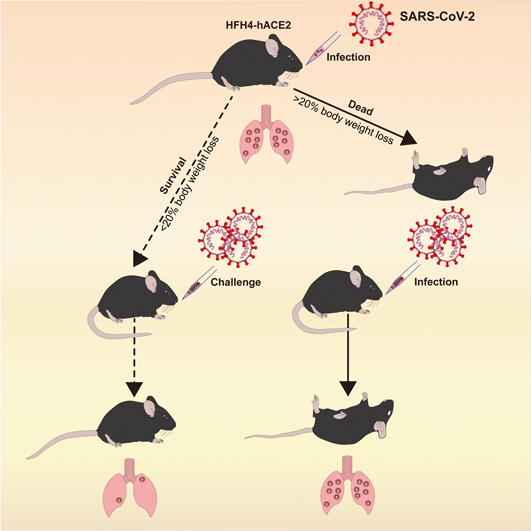Mouse infection model plays a vital role in understanding viral pathogenesis, vaccine development, and drug screening. There is no reason it should be absent from the global confrontation with the ongoing COVID-19 pandemic caused by SARS-CoV-2.

The surviving mice from the attack of a relatively small army of SARS-CoV-2 could protect the host from a stronger reinfection. (Image by WHIOV)
Previous study in March this year, Dr. SHI Zhengli, a famous Chinese virologist at the Wuhan Institute of Virology (WHIOV), Chinese Academy of Sciences, demonstrated that SARS-CoV-2 can use human, bat, or civet ACE2 (a cellular receptor rich in the lining of the blood vessels) for cell entry, but not the mouse ACE2 (Nature 2020 doi: 10.1038/s41586-020-2012-7). In other words, SARS-CoV-2 does not infect mice in nature. However, mice genetically engineered to carry the human ACE2 would become vulnerable to SARS-CoV-2 and thereby a useful tool for testing potential vaccines and therapeutics.
As reported in Cell on May 21, SHI Zhengli and YANG Xinglou, another WHIOV virologist, successfully developed a SARS-CoV-2 transgenic mouse infection model carrying the human version of ACE2 (doi: 10.1016/j.cell.2020.05.027).
They found, the infected mice generated typical interstitial pneumonia and pathology that were similar to those of COVID-19 patients. Like in humans, the lung is the primary target of this virus, although the eye, heart, and brain could also be infected in accordance with the tissue ACE2 abundance.
They also found that the surviving mice once exposed to a low amount of the virus could better withstand a reinfection at higher amounts. While the na?ve-infected mice had a hard time and developed severe symptoms, only mild pneumonia was observed in the mice that have already survived once from viral infection. Which parts of the mouse immune system enable such protection, however, remains unclear.
All in all, the hACE2 mouse established in this study, partially recapitulating the pathology of COVID-19 in humans, may provide a valuable platform for testing potential vaccines and therapeutics in the battle with SARS-CoV-2.

